Comprehensive System Analysis of Headspace Application Platform
VerifiedAdded on 2023/03/31
|10
|2187
|448
Report
AI Summary
This report delivers a comprehensive system analysis of the Headspace application, examining its non-functional requirements such as functionality, usability, reliability, performance, and security. It explores cloud-based solutions, specifically focusing on Infrastructure as a Service (IaaS), detailing its advantages and disadvantages in the context of Headspace. The report also discusses the Software Development Life Cycle (SDLC) approach, comparing predictive and adaptive methods, and suggests that an adaptive approach is more suitable for the Headspace project, enabling better user integration and faster application development. The analysis highlights the importance of factors like data concurrency, scalability, and security measures, including encryption techniques, to ensure the system's efficiency and protection against cyber threats.
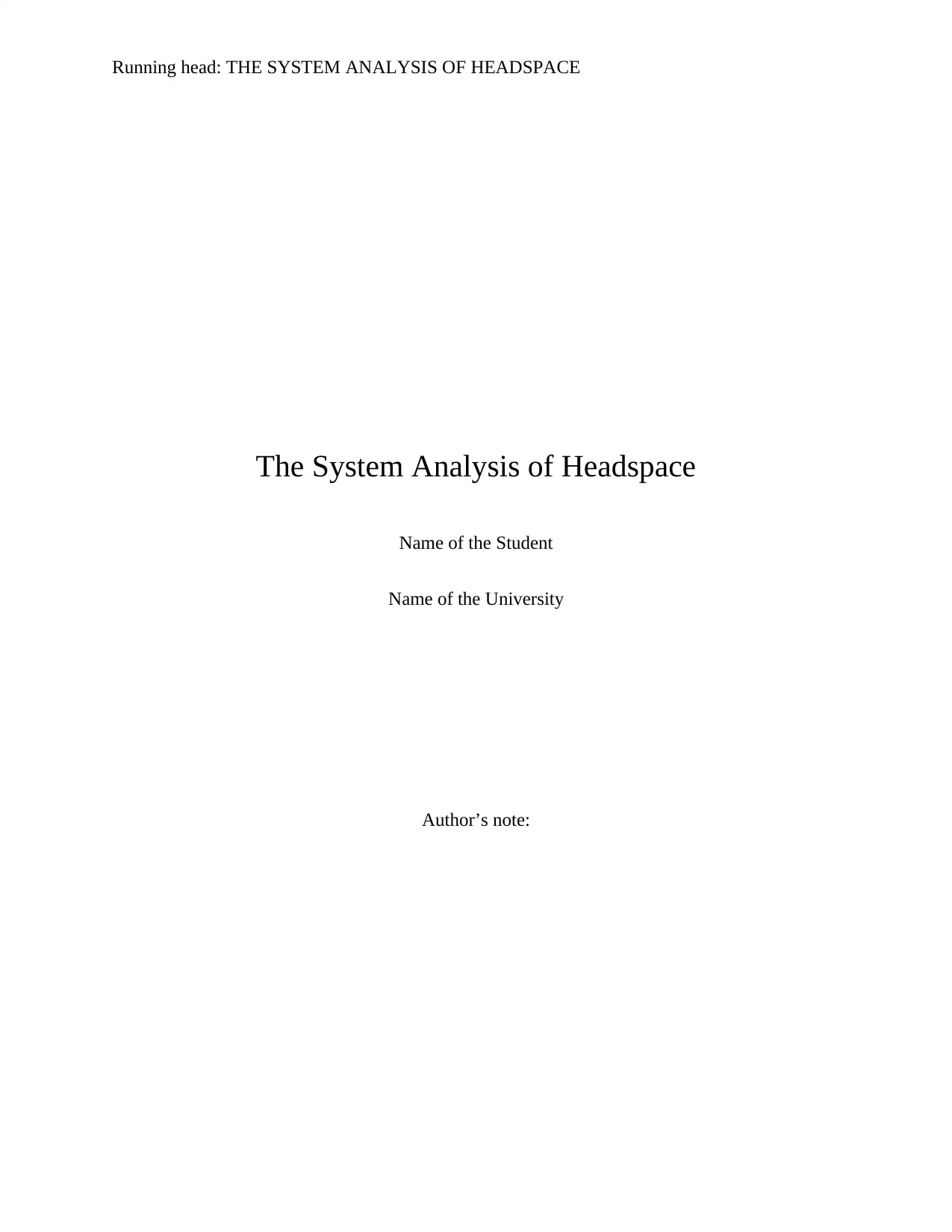
Running head: THE SYSTEM ANALYSIS OF HEADSPACE
The System Analysis of Headspace
Name of the Student
Name of the University
Author’s note:
The System Analysis of Headspace
Name of the Student
Name of the University
Author’s note:
Paraphrase This Document
Need a fresh take? Get an instant paraphrase of this document with our AI Paraphraser
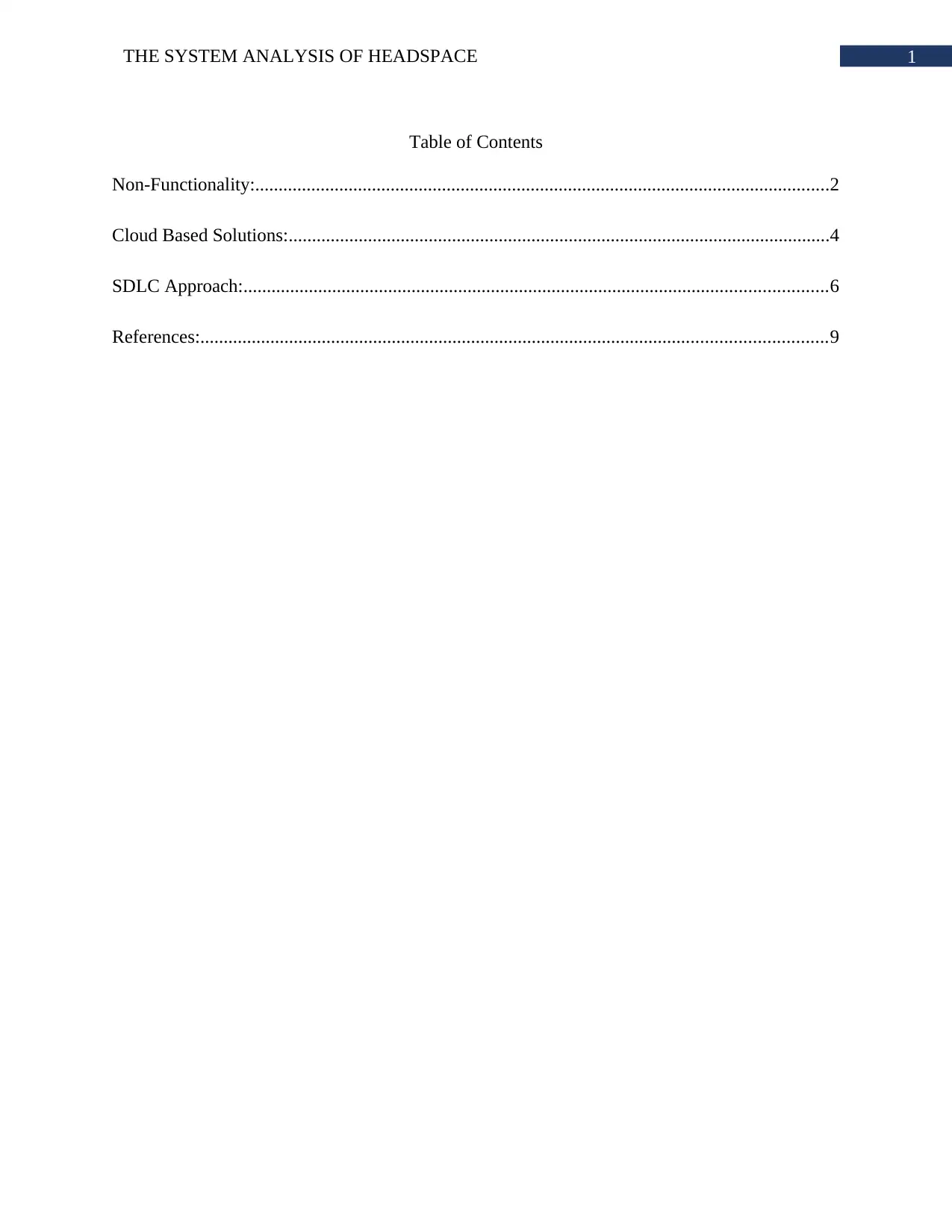
1THE SYSTEM ANALYSIS OF HEADSPACE
Table of Contents
Non-Functionality:...........................................................................................................................2
Cloud Based Solutions:....................................................................................................................4
SDLC Approach:.............................................................................................................................6
References:......................................................................................................................................9
Table of Contents
Non-Functionality:...........................................................................................................................2
Cloud Based Solutions:....................................................................................................................4
SDLC Approach:.............................................................................................................................6
References:......................................................................................................................................9
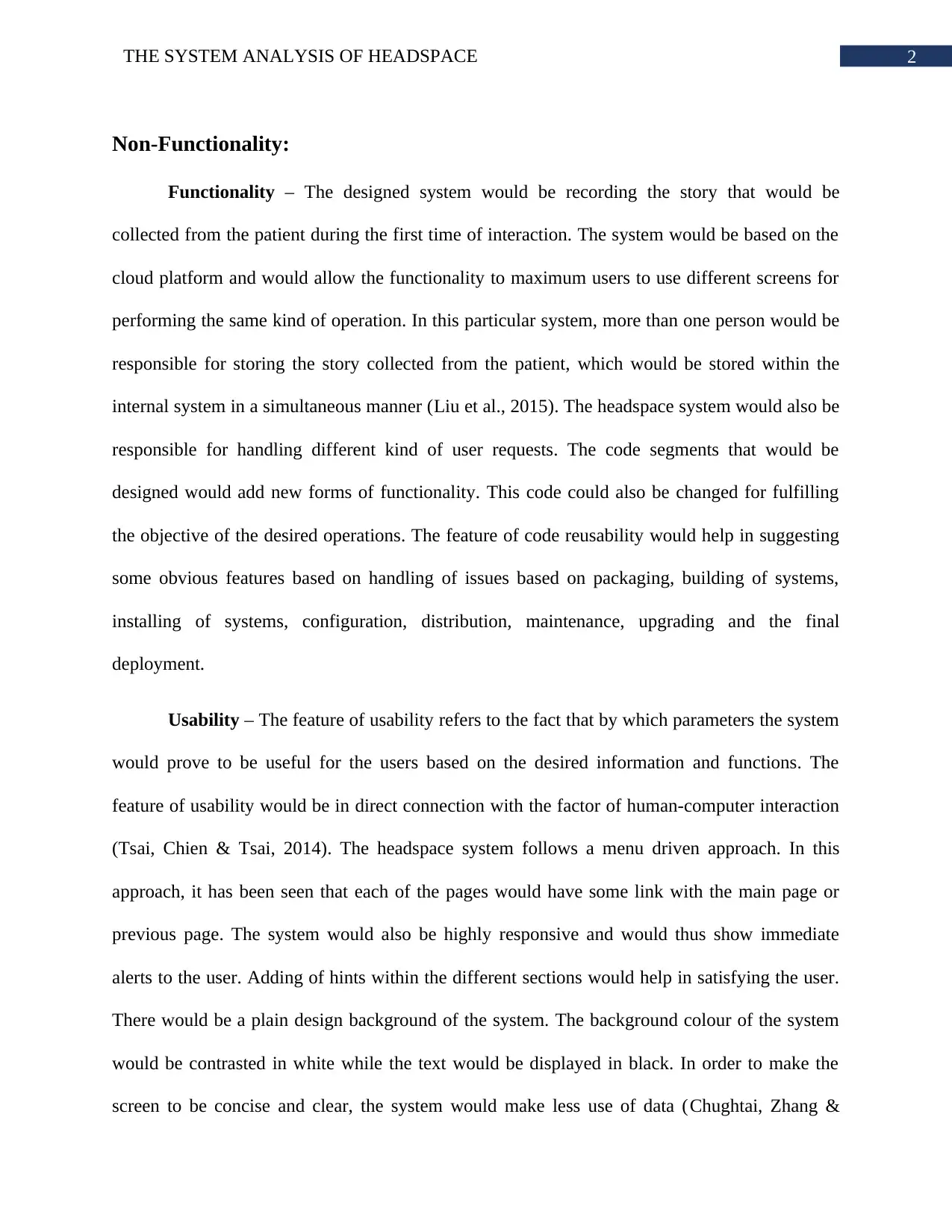
2THE SYSTEM ANALYSIS OF HEADSPACE
Non-Functionality:
Functionality – The designed system would be recording the story that would be
collected from the patient during the first time of interaction. The system would be based on the
cloud platform and would allow the functionality to maximum users to use different screens for
performing the same kind of operation. In this particular system, more than one person would be
responsible for storing the story collected from the patient, which would be stored within the
internal system in a simultaneous manner (Liu et al., 2015). The headspace system would also be
responsible for handling different kind of user requests. The code segments that would be
designed would add new forms of functionality. This code could also be changed for fulfilling
the objective of the desired operations. The feature of code reusability would help in suggesting
some obvious features based on handling of issues based on packaging, building of systems,
installing of systems, configuration, distribution, maintenance, upgrading and the final
deployment.
Usability – The feature of usability refers to the fact that by which parameters the system
would prove to be useful for the users based on the desired information and functions. The
feature of usability would be in direct connection with the factor of human-computer interaction
(Tsai, Chien & Tsai, 2014). The headspace system follows a menu driven approach. In this
approach, it has been seen that each of the pages would have some link with the main page or
previous page. The system would also be highly responsive and would thus show immediate
alerts to the user. Adding of hints within the different sections would help in satisfying the user.
There would be a plain design background of the system. The background colour of the system
would be contrasted in white while the text would be displayed in black. In order to make the
screen to be concise and clear, the system would make less use of data (Chughtai, Zhang &
Non-Functionality:
Functionality – The designed system would be recording the story that would be
collected from the patient during the first time of interaction. The system would be based on the
cloud platform and would allow the functionality to maximum users to use different screens for
performing the same kind of operation. In this particular system, more than one person would be
responsible for storing the story collected from the patient, which would be stored within the
internal system in a simultaneous manner (Liu et al., 2015). The headspace system would also be
responsible for handling different kind of user requests. The code segments that would be
designed would add new forms of functionality. This code could also be changed for fulfilling
the objective of the desired operations. The feature of code reusability would help in suggesting
some obvious features based on handling of issues based on packaging, building of systems,
installing of systems, configuration, distribution, maintenance, upgrading and the final
deployment.
Usability – The feature of usability refers to the fact that by which parameters the system
would prove to be useful for the users based on the desired information and functions. The
feature of usability would be in direct connection with the factor of human-computer interaction
(Tsai, Chien & Tsai, 2014). The headspace system follows a menu driven approach. In this
approach, it has been seen that each of the pages would have some link with the main page or
previous page. The system would also be highly responsive and would thus show immediate
alerts to the user. Adding of hints within the different sections would help in satisfying the user.
There would be a plain design background of the system. The background colour of the system
would be contrasted in white while the text would be displayed in black. In order to make the
screen to be concise and clear, the system would make less use of data (Chughtai, Zhang &
⊘ This is a preview!⊘
Do you want full access?
Subscribe today to unlock all pages.

Trusted by 1+ million students worldwide
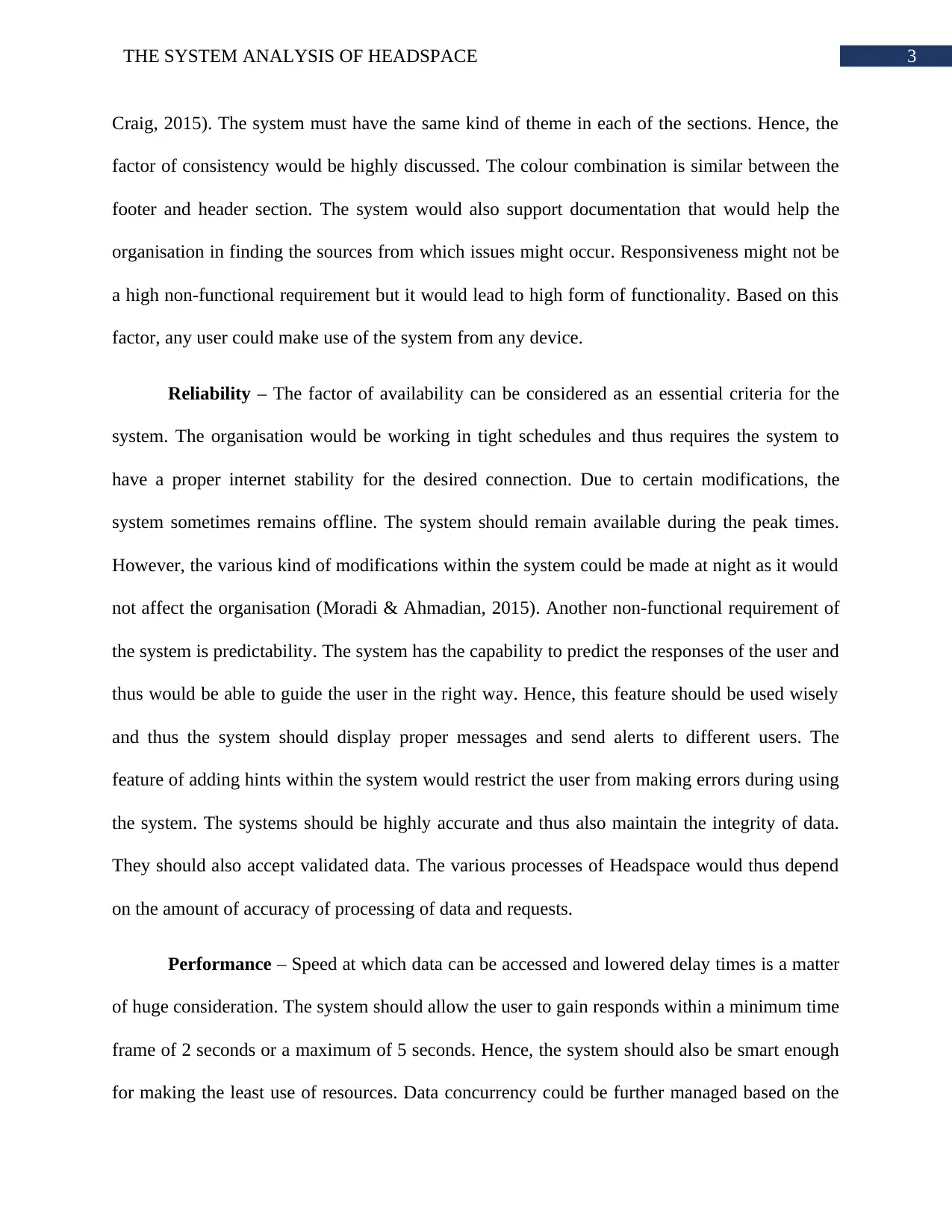
3THE SYSTEM ANALYSIS OF HEADSPACE
Craig, 2015). The system must have the same kind of theme in each of the sections. Hence, the
factor of consistency would be highly discussed. The colour combination is similar between the
footer and header section. The system would also support documentation that would help the
organisation in finding the sources from which issues might occur. Responsiveness might not be
a high non-functional requirement but it would lead to high form of functionality. Based on this
factor, any user could make use of the system from any device.
Reliability – The factor of availability can be considered as an essential criteria for the
system. The organisation would be working in tight schedules and thus requires the system to
have a proper internet stability for the desired connection. Due to certain modifications, the
system sometimes remains offline. The system should remain available during the peak times.
However, the various kind of modifications within the system could be made at night as it would
not affect the organisation (Moradi & Ahmadian, 2015). Another non-functional requirement of
the system is predictability. The system has the capability to predict the responses of the user and
thus would be able to guide the user in the right way. Hence, this feature should be used wisely
and thus the system should display proper messages and send alerts to different users. The
feature of adding hints within the system would restrict the user from making errors during using
the system. The systems should be highly accurate and thus also maintain the integrity of data.
They should also accept validated data. The various processes of Headspace would thus depend
on the amount of accuracy of processing of data and requests.
Performance – Speed at which data can be accessed and lowered delay times is a matter
of huge consideration. The system should allow the user to gain responds within a minimum time
frame of 2 seconds or a maximum of 5 seconds. Hence, the system should also be smart enough
for making the least use of resources. Data concurrency could be further managed based on the
Craig, 2015). The system must have the same kind of theme in each of the sections. Hence, the
factor of consistency would be highly discussed. The colour combination is similar between the
footer and header section. The system would also support documentation that would help the
organisation in finding the sources from which issues might occur. Responsiveness might not be
a high non-functional requirement but it would lead to high form of functionality. Based on this
factor, any user could make use of the system from any device.
Reliability – The factor of availability can be considered as an essential criteria for the
system. The organisation would be working in tight schedules and thus requires the system to
have a proper internet stability for the desired connection. Due to certain modifications, the
system sometimes remains offline. The system should remain available during the peak times.
However, the various kind of modifications within the system could be made at night as it would
not affect the organisation (Moradi & Ahmadian, 2015). Another non-functional requirement of
the system is predictability. The system has the capability to predict the responses of the user and
thus would be able to guide the user in the right way. Hence, this feature should be used wisely
and thus the system should display proper messages and send alerts to different users. The
feature of adding hints within the system would restrict the user from making errors during using
the system. The systems should be highly accurate and thus also maintain the integrity of data.
They should also accept validated data. The various processes of Headspace would thus depend
on the amount of accuracy of processing of data and requests.
Performance – Speed at which data can be accessed and lowered delay times is a matter
of huge consideration. The system should allow the user to gain responds within a minimum time
frame of 2 seconds or a maximum of 5 seconds. Hence, the system should also be smart enough
for making the least use of resources. Data concurrency could be further managed based on the
Paraphrase This Document
Need a fresh take? Get an instant paraphrase of this document with our AI Paraphraser
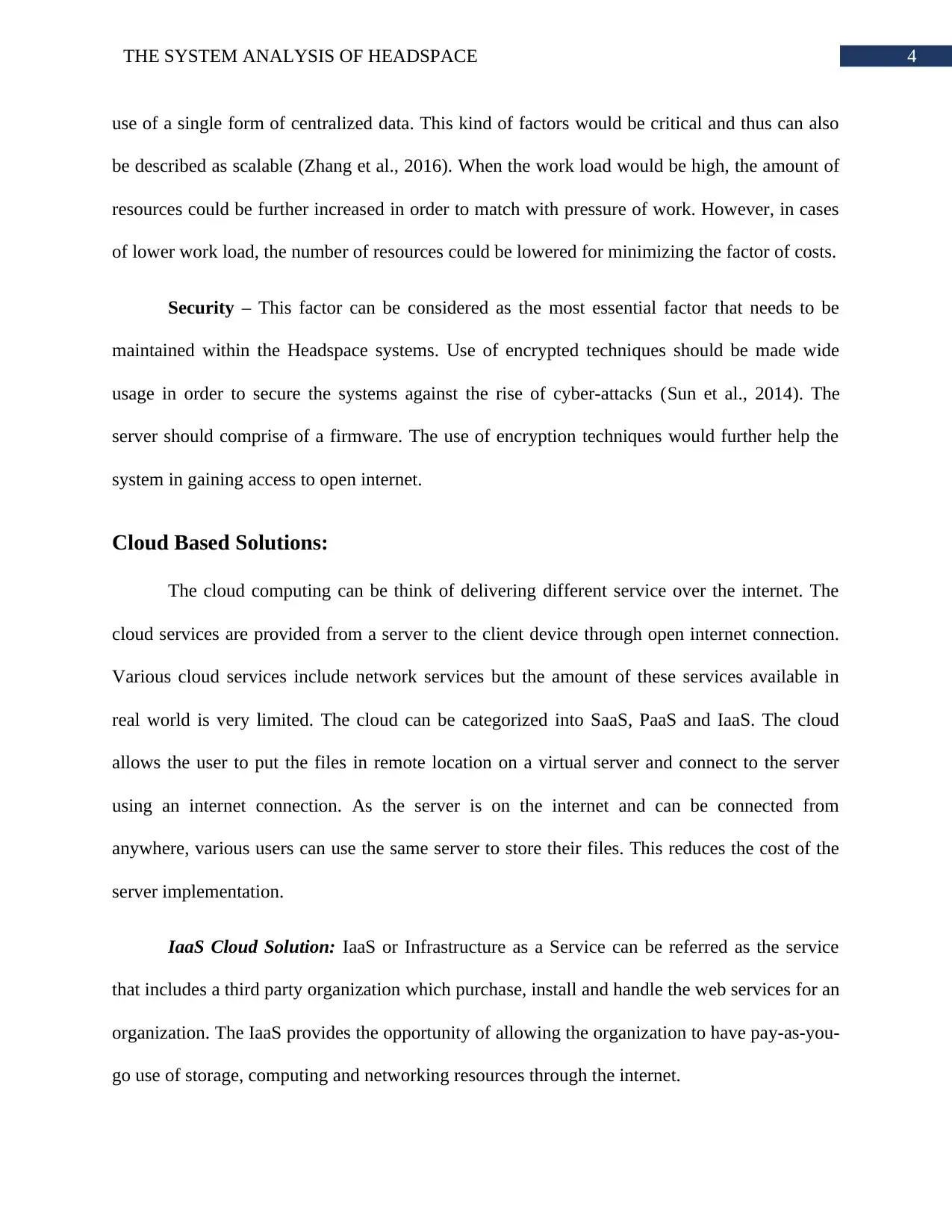
4THE SYSTEM ANALYSIS OF HEADSPACE
use of a single form of centralized data. This kind of factors would be critical and thus can also
be described as scalable (Zhang et al., 2016). When the work load would be high, the amount of
resources could be further increased in order to match with pressure of work. However, in cases
of lower work load, the number of resources could be lowered for minimizing the factor of costs.
Security – This factor can be considered as the most essential factor that needs to be
maintained within the Headspace systems. Use of encrypted techniques should be made wide
usage in order to secure the systems against the rise of cyber-attacks (Sun et al., 2014). The
server should comprise of a firmware. The use of encryption techniques would further help the
system in gaining access to open internet.
Cloud Based Solutions:
The cloud computing can be think of delivering different service over the internet. The
cloud services are provided from a server to the client device through open internet connection.
Various cloud services include network services but the amount of these services available in
real world is very limited. The cloud can be categorized into SaaS, PaaS and IaaS. The cloud
allows the user to put the files in remote location on a virtual server and connect to the server
using an internet connection. As the server is on the internet and can be connected from
anywhere, various users can use the same server to store their files. This reduces the cost of the
server implementation.
IaaS Cloud Solution: IaaS or Infrastructure as a Service can be referred as the service
that includes a third party organization which purchase, install and handle the web services for an
organization. The IaaS provides the opportunity of allowing the organization to have pay-as-you-
go use of storage, computing and networking resources through the internet.
use of a single form of centralized data. This kind of factors would be critical and thus can also
be described as scalable (Zhang et al., 2016). When the work load would be high, the amount of
resources could be further increased in order to match with pressure of work. However, in cases
of lower work load, the number of resources could be lowered for minimizing the factor of costs.
Security – This factor can be considered as the most essential factor that needs to be
maintained within the Headspace systems. Use of encrypted techniques should be made wide
usage in order to secure the systems against the rise of cyber-attacks (Sun et al., 2014). The
server should comprise of a firmware. The use of encryption techniques would further help the
system in gaining access to open internet.
Cloud Based Solutions:
The cloud computing can be think of delivering different service over the internet. The
cloud services are provided from a server to the client device through open internet connection.
Various cloud services include network services but the amount of these services available in
real world is very limited. The cloud can be categorized into SaaS, PaaS and IaaS. The cloud
allows the user to put the files in remote location on a virtual server and connect to the server
using an internet connection. As the server is on the internet and can be connected from
anywhere, various users can use the same server to store their files. This reduces the cost of the
server implementation.
IaaS Cloud Solution: IaaS or Infrastructure as a Service can be referred as the service
that includes a third party organization which purchase, install and handle the web services for an
organization. The IaaS provides the opportunity of allowing the organization to have pay-as-you-
go use of storage, computing and networking resources through the internet.
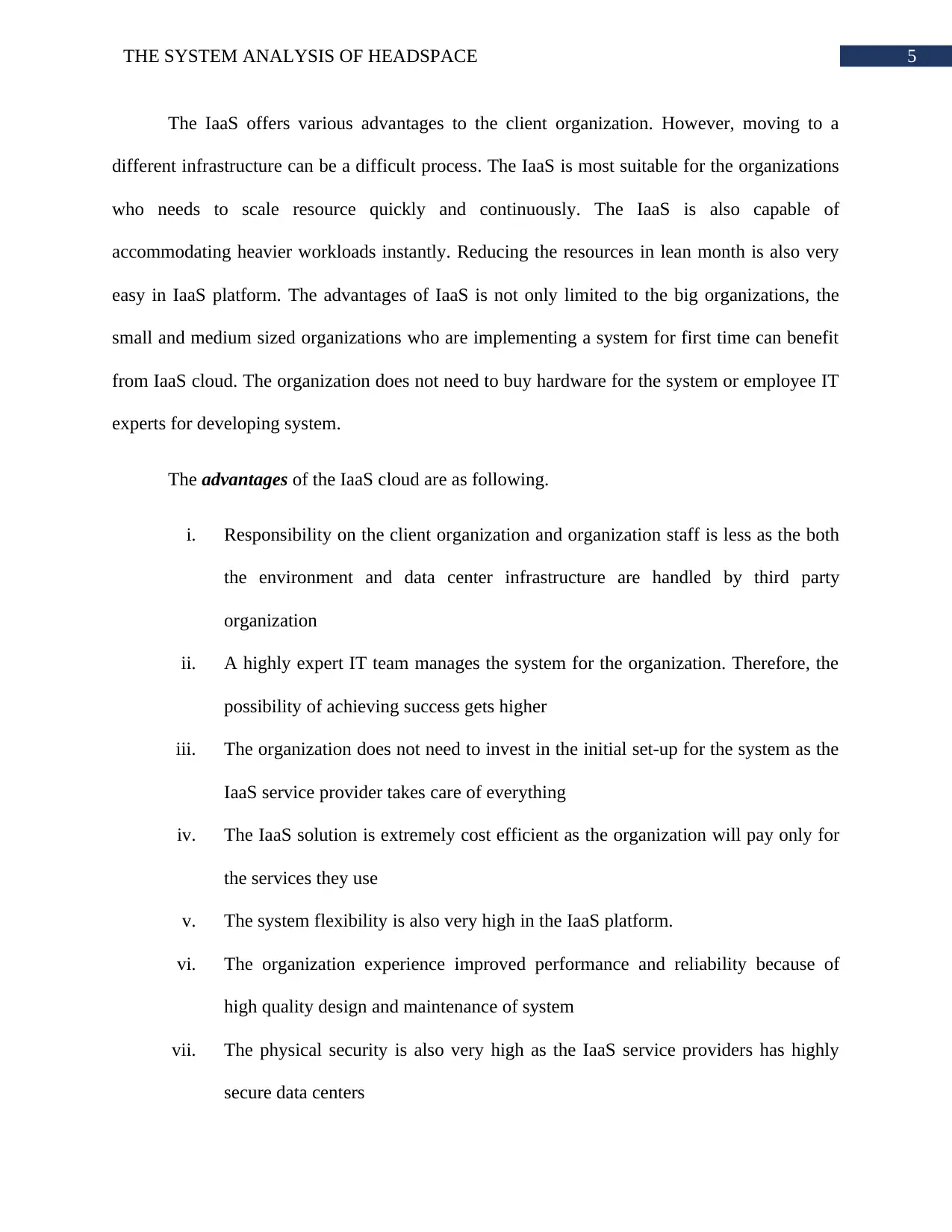
5THE SYSTEM ANALYSIS OF HEADSPACE
The IaaS offers various advantages to the client organization. However, moving to a
different infrastructure can be a difficult process. The IaaS is most suitable for the organizations
who needs to scale resource quickly and continuously. The IaaS is also capable of
accommodating heavier workloads instantly. Reducing the resources in lean month is also very
easy in IaaS platform. The advantages of IaaS is not only limited to the big organizations, the
small and medium sized organizations who are implementing a system for first time can benefit
from IaaS cloud. The organization does not need to buy hardware for the system or employee IT
experts for developing system.
The advantages of the IaaS cloud are as following.
i. Responsibility on the client organization and organization staff is less as the both
the environment and data center infrastructure are handled by third party
organization
ii. A highly expert IT team manages the system for the organization. Therefore, the
possibility of achieving success gets higher
iii. The organization does not need to invest in the initial set-up for the system as the
IaaS service provider takes care of everything
iv. The IaaS solution is extremely cost efficient as the organization will pay only for
the services they use
v. The system flexibility is also very high in the IaaS platform.
vi. The organization experience improved performance and reliability because of
high quality design and maintenance of system
vii. The physical security is also very high as the IaaS service providers has highly
secure data centers
The IaaS offers various advantages to the client organization. However, moving to a
different infrastructure can be a difficult process. The IaaS is most suitable for the organizations
who needs to scale resource quickly and continuously. The IaaS is also capable of
accommodating heavier workloads instantly. Reducing the resources in lean month is also very
easy in IaaS platform. The advantages of IaaS is not only limited to the big organizations, the
small and medium sized organizations who are implementing a system for first time can benefit
from IaaS cloud. The organization does not need to buy hardware for the system or employee IT
experts for developing system.
The advantages of the IaaS cloud are as following.
i. Responsibility on the client organization and organization staff is less as the both
the environment and data center infrastructure are handled by third party
organization
ii. A highly expert IT team manages the system for the organization. Therefore, the
possibility of achieving success gets higher
iii. The organization does not need to invest in the initial set-up for the system as the
IaaS service provider takes care of everything
iv. The IaaS solution is extremely cost efficient as the organization will pay only for
the services they use
v. The system flexibility is also very high in the IaaS platform.
vi. The organization experience improved performance and reliability because of
high quality design and maintenance of system
vii. The physical security is also very high as the IaaS service providers has highly
secure data centers
⊘ This is a preview!⊘
Do you want full access?
Subscribe today to unlock all pages.

Trusted by 1+ million students worldwide
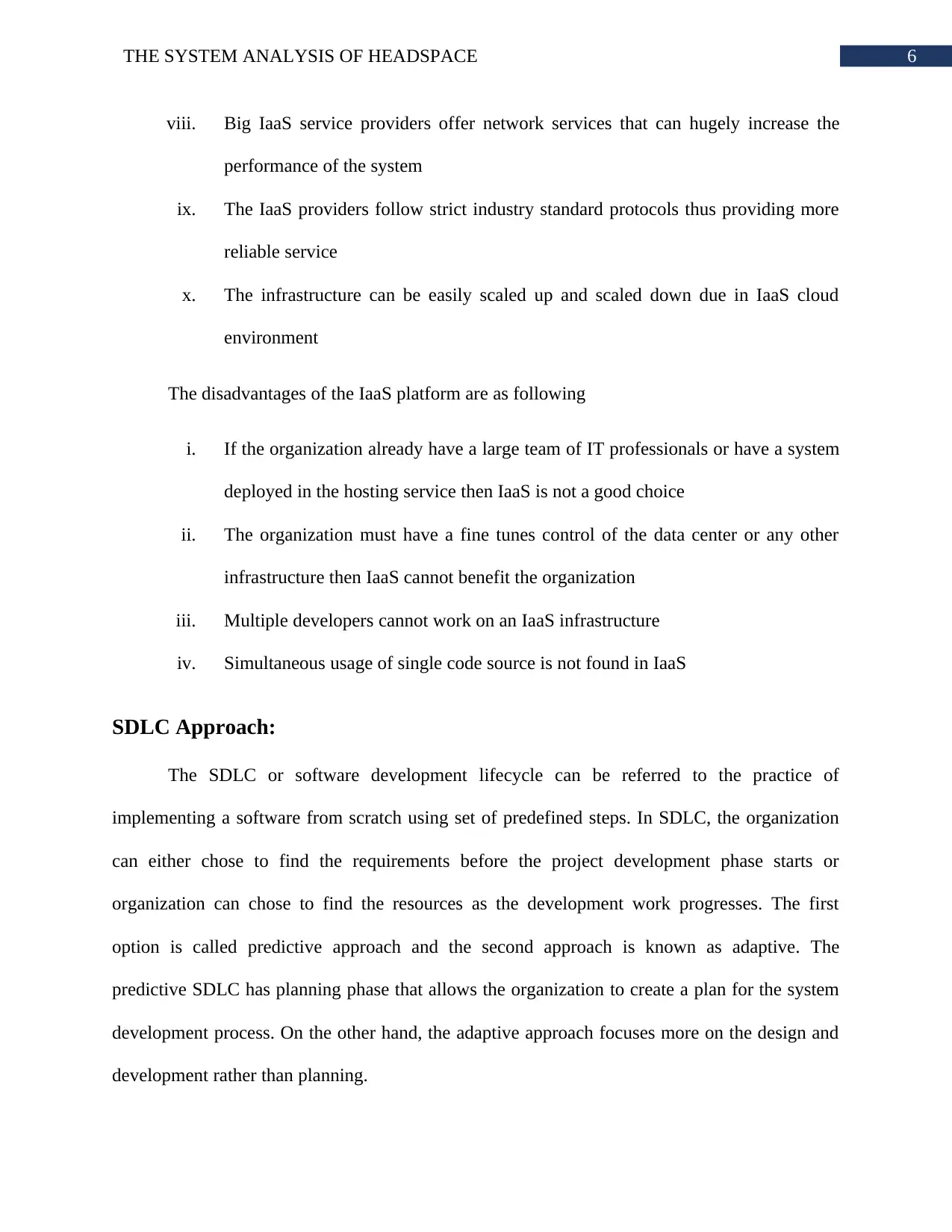
6THE SYSTEM ANALYSIS OF HEADSPACE
viii. Big IaaS service providers offer network services that can hugely increase the
performance of the system
ix. The IaaS providers follow strict industry standard protocols thus providing more
reliable service
x. The infrastructure can be easily scaled up and scaled down due in IaaS cloud
environment
The disadvantages of the IaaS platform are as following
i. If the organization already have a large team of IT professionals or have a system
deployed in the hosting service then IaaS is not a good choice
ii. The organization must have a fine tunes control of the data center or any other
infrastructure then IaaS cannot benefit the organization
iii. Multiple developers cannot work on an IaaS infrastructure
iv. Simultaneous usage of single code source is not found in IaaS
SDLC Approach:
The SDLC or software development lifecycle can be referred to the practice of
implementing a software from scratch using set of predefined steps. In SDLC, the organization
can either chose to find the requirements before the project development phase starts or
organization can chose to find the resources as the development work progresses. The first
option is called predictive approach and the second approach is known as adaptive. The
predictive SDLC has planning phase that allows the organization to create a plan for the system
development process. On the other hand, the adaptive approach focuses more on the design and
development rather than planning.
viii. Big IaaS service providers offer network services that can hugely increase the
performance of the system
ix. The IaaS providers follow strict industry standard protocols thus providing more
reliable service
x. The infrastructure can be easily scaled up and scaled down due in IaaS cloud
environment
The disadvantages of the IaaS platform are as following
i. If the organization already have a large team of IT professionals or have a system
deployed in the hosting service then IaaS is not a good choice
ii. The organization must have a fine tunes control of the data center or any other
infrastructure then IaaS cannot benefit the organization
iii. Multiple developers cannot work on an IaaS infrastructure
iv. Simultaneous usage of single code source is not found in IaaS
SDLC Approach:
The SDLC or software development lifecycle can be referred to the practice of
implementing a software from scratch using set of predefined steps. In SDLC, the organization
can either chose to find the requirements before the project development phase starts or
organization can chose to find the resources as the development work progresses. The first
option is called predictive approach and the second approach is known as adaptive. The
predictive SDLC has planning phase that allows the organization to create a plan for the system
development process. On the other hand, the adaptive approach focuses more on the design and
development rather than planning.
Paraphrase This Document
Need a fresh take? Get an instant paraphrase of this document with our AI Paraphraser
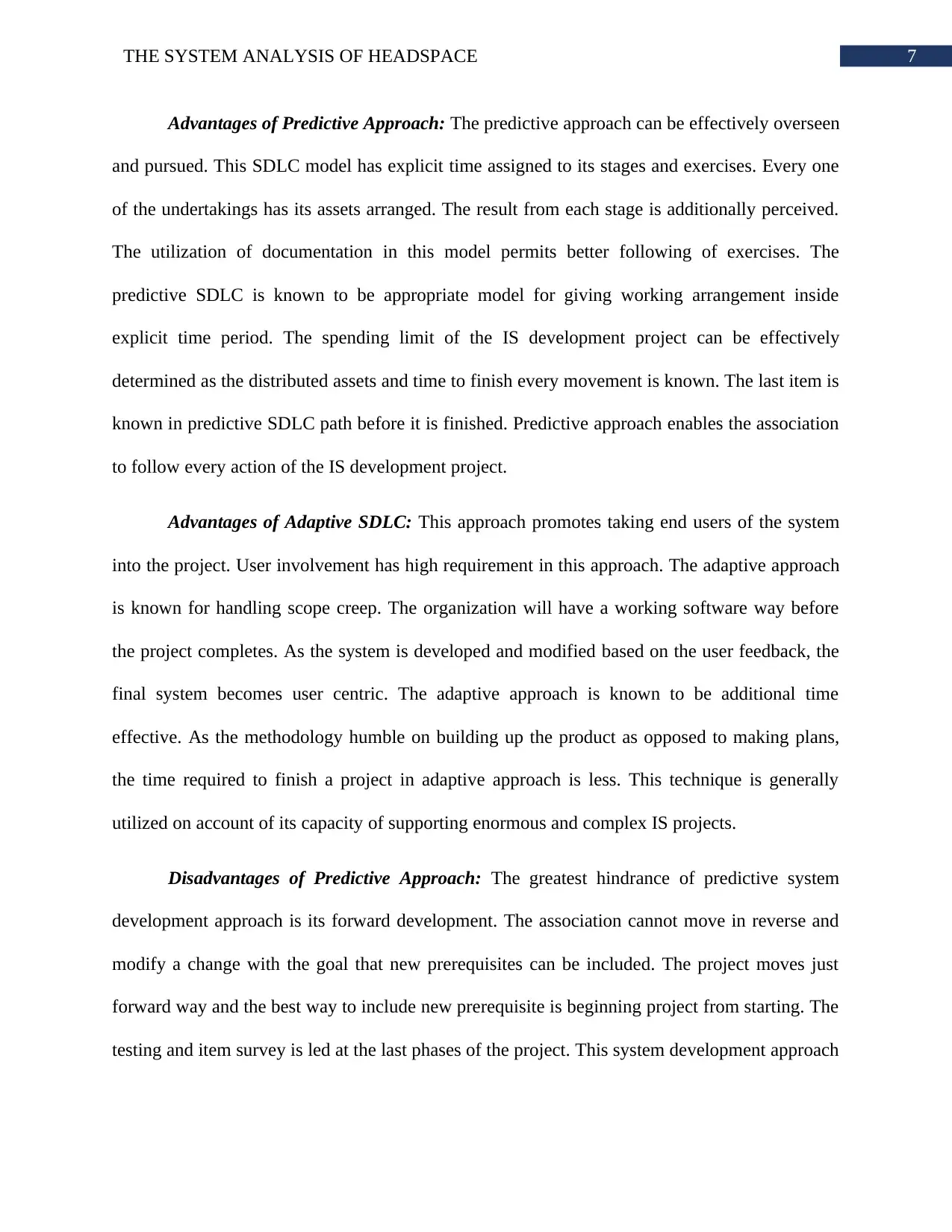
7THE SYSTEM ANALYSIS OF HEADSPACE
Advantages of Predictive Approach: The predictive approach can be effectively overseen
and pursued. This SDLC model has explicit time assigned to its stages and exercises. Every one
of the undertakings has its assets arranged. The result from each stage is additionally perceived.
The utilization of documentation in this model permits better following of exercises. The
predictive SDLC is known to be appropriate model for giving working arrangement inside
explicit time period. The spending limit of the IS development project can be effectively
determined as the distributed assets and time to finish every movement is known. The last item is
known in predictive SDLC path before it is finished. Predictive approach enables the association
to follow every action of the IS development project.
Advantages of Adaptive SDLC: This approach promotes taking end users of the system
into the project. User involvement has high requirement in this approach. The adaptive approach
is known for handling scope creep. The organization will have a working software way before
the project completes. As the system is developed and modified based on the user feedback, the
final system becomes user centric. The adaptive approach is known to be additional time
effective. As the methodology humble on building up the product as opposed to making plans,
the time required to finish a project in adaptive approach is less. This technique is generally
utilized on account of its capacity of supporting enormous and complex IS projects.
Disadvantages of Predictive Approach: The greatest hindrance of predictive system
development approach is its forward development. The association cannot move in reverse and
modify a change with the goal that new prerequisites can be included. The project moves just
forward way and the best way to include new prerequisite is beginning project from starting. The
testing and item survey is led at the last phases of the project. This system development approach
Advantages of Predictive Approach: The predictive approach can be effectively overseen
and pursued. This SDLC model has explicit time assigned to its stages and exercises. Every one
of the undertakings has its assets arranged. The result from each stage is additionally perceived.
The utilization of documentation in this model permits better following of exercises. The
predictive SDLC is known to be appropriate model for giving working arrangement inside
explicit time period. The spending limit of the IS development project can be effectively
determined as the distributed assets and time to finish every movement is known. The last item is
known in predictive SDLC path before it is finished. Predictive approach enables the association
to follow every action of the IS development project.
Advantages of Adaptive SDLC: This approach promotes taking end users of the system
into the project. User involvement has high requirement in this approach. The adaptive approach
is known for handling scope creep. The organization will have a working software way before
the project completes. As the system is developed and modified based on the user feedback, the
final system becomes user centric. The adaptive approach is known to be additional time
effective. As the methodology humble on building up the product as opposed to making plans,
the time required to finish a project in adaptive approach is less. This technique is generally
utilized on account of its capacity of supporting enormous and complex IS projects.
Disadvantages of Predictive Approach: The greatest hindrance of predictive system
development approach is its forward development. The association cannot move in reverse and
modify a change with the goal that new prerequisites can be included. The project moves just
forward way and the best way to include new prerequisite is beginning project from starting. The
testing and item survey is led at the last phases of the project. This system development approach
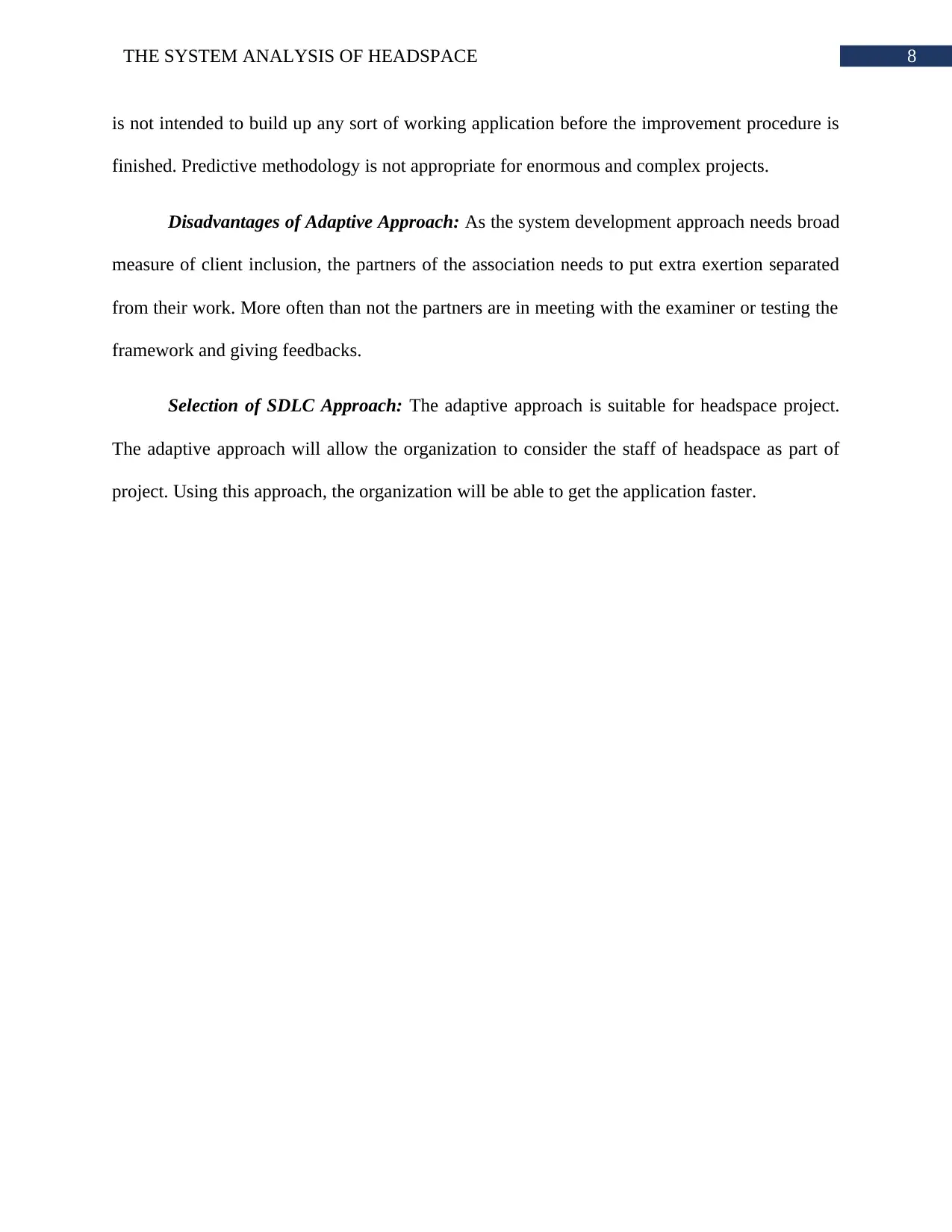
8THE SYSTEM ANALYSIS OF HEADSPACE
is not intended to build up any sort of working application before the improvement procedure is
finished. Predictive methodology is not appropriate for enormous and complex projects.
Disadvantages of Adaptive Approach: As the system development approach needs broad
measure of client inclusion, the partners of the association needs to put extra exertion separated
from their work. More often than not the partners are in meeting with the examiner or testing the
framework and giving feedbacks.
Selection of SDLC Approach: The adaptive approach is suitable for headspace project.
The adaptive approach will allow the organization to consider the staff of headspace as part of
project. Using this approach, the organization will be able to get the application faster.
is not intended to build up any sort of working application before the improvement procedure is
finished. Predictive methodology is not appropriate for enormous and complex projects.
Disadvantages of Adaptive Approach: As the system development approach needs broad
measure of client inclusion, the partners of the association needs to put extra exertion separated
from their work. More often than not the partners are in meeting with the examiner or testing the
framework and giving feedbacks.
Selection of SDLC Approach: The adaptive approach is suitable for headspace project.
The adaptive approach will allow the organization to consider the staff of headspace as part of
project. Using this approach, the organization will be able to get the application faster.
⊘ This is a preview!⊘
Do you want full access?
Subscribe today to unlock all pages.

Trusted by 1+ million students worldwide
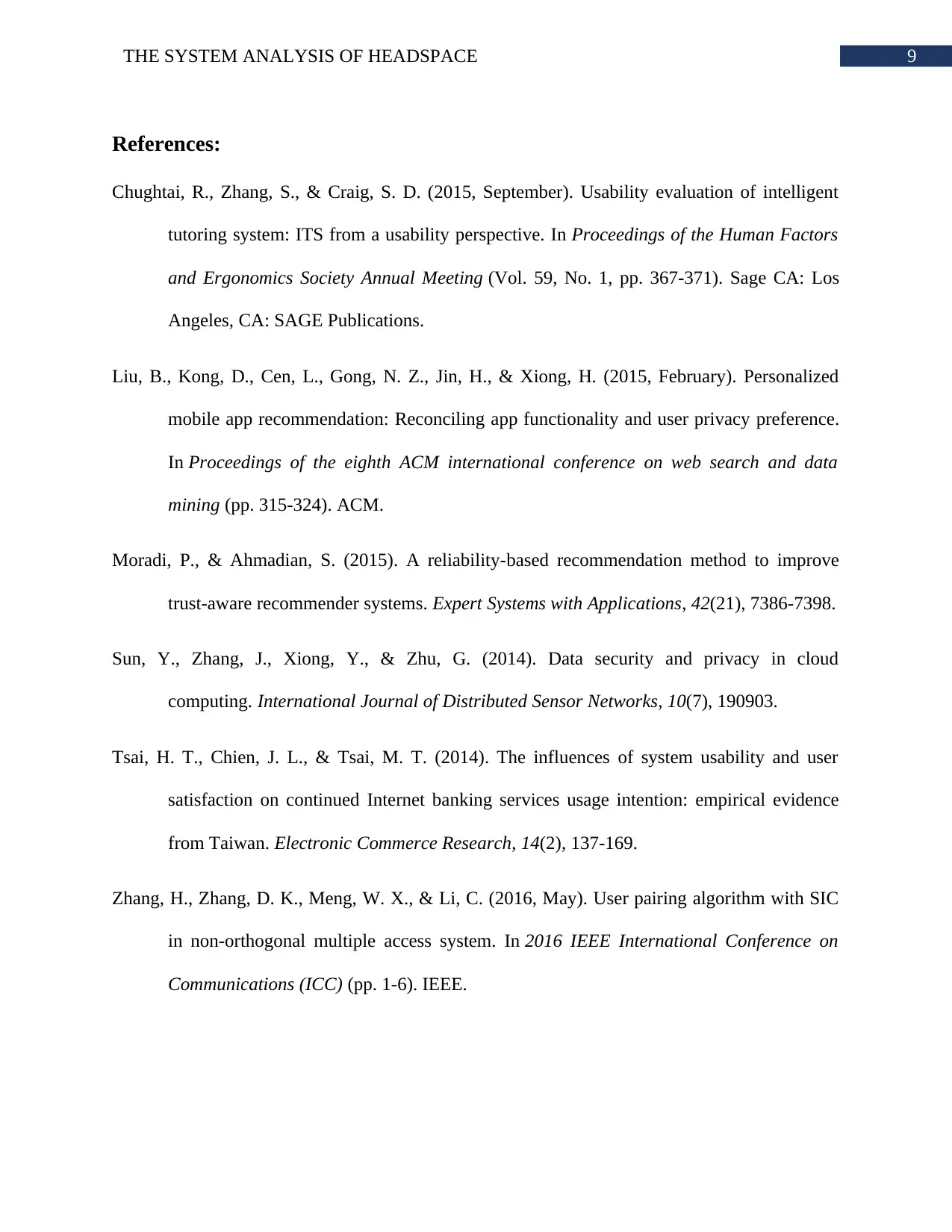
9THE SYSTEM ANALYSIS OF HEADSPACE
References:
Chughtai, R., Zhang, S., & Craig, S. D. (2015, September). Usability evaluation of intelligent
tutoring system: ITS from a usability perspective. In Proceedings of the Human Factors
and Ergonomics Society Annual Meeting (Vol. 59, No. 1, pp. 367-371). Sage CA: Los
Angeles, CA: SAGE Publications.
Liu, B., Kong, D., Cen, L., Gong, N. Z., Jin, H., & Xiong, H. (2015, February). Personalized
mobile app recommendation: Reconciling app functionality and user privacy preference.
In Proceedings of the eighth ACM international conference on web search and data
mining (pp. 315-324). ACM.
Moradi, P., & Ahmadian, S. (2015). A reliability-based recommendation method to improve
trust-aware recommender systems. Expert Systems with Applications, 42(21), 7386-7398.
Sun, Y., Zhang, J., Xiong, Y., & Zhu, G. (2014). Data security and privacy in cloud
computing. International Journal of Distributed Sensor Networks, 10(7), 190903.
Tsai, H. T., Chien, J. L., & Tsai, M. T. (2014). The influences of system usability and user
satisfaction on continued Internet banking services usage intention: empirical evidence
from Taiwan. Electronic Commerce Research, 14(2), 137-169.
Zhang, H., Zhang, D. K., Meng, W. X., & Li, C. (2016, May). User pairing algorithm with SIC
in non-orthogonal multiple access system. In 2016 IEEE International Conference on
Communications (ICC) (pp. 1-6). IEEE.
References:
Chughtai, R., Zhang, S., & Craig, S. D. (2015, September). Usability evaluation of intelligent
tutoring system: ITS from a usability perspective. In Proceedings of the Human Factors
and Ergonomics Society Annual Meeting (Vol. 59, No. 1, pp. 367-371). Sage CA: Los
Angeles, CA: SAGE Publications.
Liu, B., Kong, D., Cen, L., Gong, N. Z., Jin, H., & Xiong, H. (2015, February). Personalized
mobile app recommendation: Reconciling app functionality and user privacy preference.
In Proceedings of the eighth ACM international conference on web search and data
mining (pp. 315-324). ACM.
Moradi, P., & Ahmadian, S. (2015). A reliability-based recommendation method to improve
trust-aware recommender systems. Expert Systems with Applications, 42(21), 7386-7398.
Sun, Y., Zhang, J., Xiong, Y., & Zhu, G. (2014). Data security and privacy in cloud
computing. International Journal of Distributed Sensor Networks, 10(7), 190903.
Tsai, H. T., Chien, J. L., & Tsai, M. T. (2014). The influences of system usability and user
satisfaction on continued Internet banking services usage intention: empirical evidence
from Taiwan. Electronic Commerce Research, 14(2), 137-169.
Zhang, H., Zhang, D. K., Meng, W. X., & Li, C. (2016, May). User pairing algorithm with SIC
in non-orthogonal multiple access system. In 2016 IEEE International Conference on
Communications (ICC) (pp. 1-6). IEEE.
1 out of 10
Related Documents
Your All-in-One AI-Powered Toolkit for Academic Success.
+13062052269
info@desklib.com
Available 24*7 on WhatsApp / Email
![[object Object]](/_next/static/media/star-bottom.7253800d.svg)
Unlock your academic potential
Copyright © 2020–2025 A2Z Services. All Rights Reserved. Developed and managed by ZUCOL.




